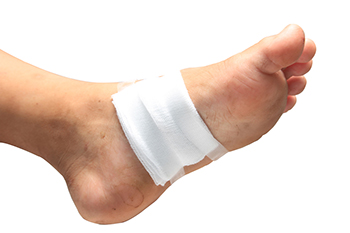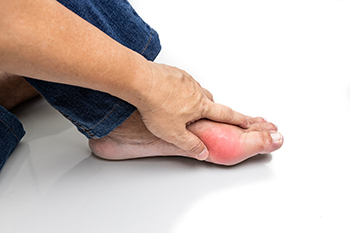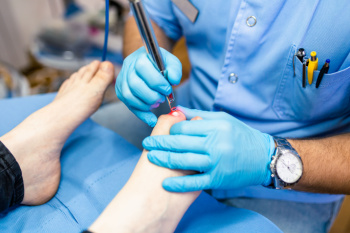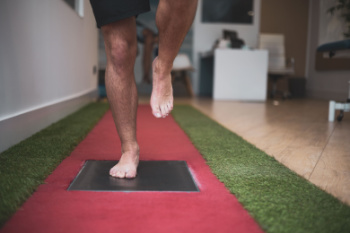Items filtered by date: October 2024
How Diabetes Affects Wound Healing

Diabetes can significantly impair wound healing, particularly in the feet, where the risk of complications is higher. Elevated blood glucose levels in diabetic patients disrupt vital healing processes that delay tissue repair. For instance, diabetes often leads to poor circulation, which reduces oxygen and nutrient delivery to wound sites and further slows healing. Diabetic neuropathy, or nerve damage, makes it difficult for patients to feel foot injuries, which allows wounds to go untreated and increases the risk of infection. Meanwhile, the immune system is often weakened by this disease, making it harder for the body to fight infections that can further delay healing. Regular foot checks and early intervention are essential to managing foot wounds for people who are diabetic. If you have foot wounds that will not heal, it is suggested that you include a podiatrist as part of your medical team for treatment.
Wound care is an important part in dealing with diabetes. If you have diabetes and a foot wound or would like more information about wound care for diabetics, consult with Richard Galperin, DPM from Texas. Our doctor will assess your condition and provide you with quality foot and ankle treatment.
What Is Wound Care?
Wound care is the practice of taking proper care of a wound. This can range from the smallest to the largest of wounds. While everyone can benefit from proper wound care, it is much more important for diabetics. Diabetics often suffer from poor blood circulation which causes wounds to heal much slower than they would in a non-diabetic.
What Is the Importance of Wound Care?
While it may not seem apparent with small ulcers on the foot, for diabetics, any size ulcer can become infected. Diabetics often also suffer from neuropathy, or nerve loss. This means they might not even feel when they have an ulcer on their foot. If the wound becomes severely infected, amputation may be necessary. Therefore, it is of the upmost importance to properly care for any and all foot wounds.
How to Care for Wounds
The best way to care for foot wounds is to prevent them. For diabetics, this means daily inspections of the feet for any signs of abnormalities or ulcers. It is also recommended to see a podiatrist several times a year for a foot inspection. If you do have an ulcer, run the wound under water to clear dirt from the wound; then apply antibiotic ointment to the wound and cover with a bandage. Bandages should be changed daily and keeping pressure off the wound is smart. It is advised to see a podiatrist, who can keep an eye on it.
If you have any questions, please feel free to contact our office located in Dallas, TX . We offer the newest diagnostic and treatment technologies for all your foot care needs.
Causes and Risk Factors for Gout

Gout is caused by an excess buildup of uric acid in the body, leading to the formation of sharp, needle-like crystals in the joints. Gout often affects the joint at the base of the big toe, resulting in sudden and severe pain, swelling, and redness. The affected area may feel warm, tender, and inflamed, making it difficult to put weight on the foot. These intense symptoms typically occur at night and can disrupt sleep. After the initial flare-up of gout, the extreme pain may subside, but discomfort and joint stiffness may persist for several days. Gout also may impact range of motion in the affected joint. Risk factors include a diet high in purine-rich foods, such as red meat and seafood, as well as excessive alcohol consumption and certain medications that raise uric acid levels. Other contributing factors include kidney disease, high blood pressure, and obesity. If you have symptoms of gout, it is suggested that you schedule an appointment with a podiatrist for a diagnosis and treatment options.
Gout is a foot condition that requires certain treatment and care. If you are seeking treatment, contact Richard Galperin, DPM from Texas. Our doctor will treat your foot and ankle needs.
What Is Gout?
Gout is a type of arthritis caused by a buildup of uric acid in the bloodstream. It often develops in the foot, especially the big toe area, although it can manifest in other parts of the body as well. Gout can make walking and standing very painful and is especially common in diabetics and the obese.
People typically get gout because of a poor diet. Genetic predisposition is also a factor. The children of parents who have had gout frequently have a chance of developing it themselves.
Gout can easily be identified by redness and inflammation of the big toe and the surrounding areas of the foot. Other symptoms include extreme fatigue, joint pain, and running high fevers. Sometimes corticosteroid drugs can be prescribed to treat gout, but the best way to combat this disease is to get more exercise and eat a better diet.
If you have any questions please feel free to contact our office located in Dallas, TX . We offer the newest diagnostic and treatment technologies for all your foot and ankle needs.
Bypass Bunion Surgery with Custom Orthotics

Considering bunion surgery? Think again. Custom Orthotics offer a non-surgical approach to reduce pain and restore foot function. Customized to your foot's structure, they realign and redistribute pressure, alleviating bunion discomfort. Experience the freedom of movement without the downtime and risks of surgery. Contact our office to make an appointment.
Let the Expert Treat Your Ingrown Toenails
Causes and Symptoms of Bunions

Bunions are common foot deformities involving a bony bump that forms on the joint at the base of the big toe. This causes the top of the toe to angle toward the smaller toes. Such a misalignment can lead to pain, redness, and swelling in the area. Over time, the bunion can worsen and may lead to stiffness or arthritis in the joint. Factors that contribute to bunion formation include abnormal foot mechanics, genetics, and wearing tight or high-heeled shoes. Symptoms can range from mild discomfort to severe pain, making walking and wearing shoes challenging. A lesser-known foot deformity called a bunionette can occur at the base of the pinky toe with similar symptoms. A podiatrist can evaluate the severity of the bunion through clinical examination and imaging tests. Treatment options include custom orthotics for foot support and surgery, if deemed necessary. If you have a painful bunion, it is suggested that you schedule an appointment with a podiatrist.
If you are suffering from bunion pain, contact Richard Galperin, DPM of Texas. Our doctor can provide the care you need to keep you pain-free and on your feet.
What Is a Bunion?
Bunions are painful bony bumps that usually develop on the inside of the foot at the joint of the big toe. As the deformity increases over time, it may become painful to walk and wear shoes. Women are more likely to exacerbate existing bunions since they often wear tight, narrow shoes that shift their toes together. Bunion pain can be relieved by wearing wider shoes with enough room for the toes.
Causes
- Genetics – some people inherit feet that are more prone to bunion development
- Inflammatory Conditions - rheumatoid arthritis and polio may cause bunion development
Symptoms
- Redness and inflammation
- Pain and tenderness
- Callus or corns on the bump
- Restricted motion in the big toe
In order to diagnose your bunion, your podiatrist may ask about your medical history, symptoms, and general health. Your doctor might also order an x-ray to take a closer look at your feet. Nonsurgical treatment options include orthotics, padding, icing, changes in footwear, and medication. If nonsurgical treatments don’t alleviate your bunion pain, surgery may be necessary.
If you have any questions, please feel free to contact our office located in Dallas, TX . We offer the newest diagnostic and treatment technologies for all your foot care needs.
Will Custom Orthotics Help You?

Custom orthotics are often recommended when pain or fatigue in the foot, bones, joints, ligaments, or tendons interferes with daily activities. These devices that fit into the shoe are tailored to address specific issues, providing targeted support that off-the-shelf solutions often cannot achieve. The need for custom orthotics arises in various situations, such as when foot mechanics are abnormal, leading to conditions like plantar fasciitis, flat feet, or overpronation. Orthotics can also help when pain extends to other parts of the body, such as the knees, hips, or lower back, as a result of improper foot alignment. There are different types of custom orthotics, including soft, semi-rigid, accommodative, and rigid, each designed to meet specific needs. Choosing the appropriate orthotic is key to effectively relieving pain and restoring function. If you are suffering with discomfort in your feet, ankles, or other related body parts, it is suggested that you visit a podiatrist who can determine which type of orthotic is right for you based on your symptoms and the underlying cause of your discomfort.
Experience a transformative solution to heel pain and foot pain through the personalized benefits of custom orthotics and shoe inserts. If you’re grappling with the persistent agony of plantar fasciitis, these customized inserts are designed to alleviate the strain on the plantar fascia, providing targeted relief. Engineered to adapt to your unique foot anatomy, custom orthotics tackle not only plantar fasciitis but also general foot and heel pain, offering unparalleled support and comfort. Don’t let every step be a reminder of discomfort; step into a world of tailored well-being. Say farewell to the limitations imposed by heel pain and embrace the freedom of pain-free mobility. Invest in your foot health and redefine your daily stride with the transformative power of custom orthotics and shoe inserts, ensuring each step is a step towards lasting comfort.
If you have any questions please contact our office located in Dallas, TX . We offer the newest diagnostic and treatment technologies for all your foot and ankle needs.
Pros and Cons of Laser Toenail Fungus Removal

Toenail laser treatment has gained popularity as a treatment for toenail fungal infections, offering a modern alternative to traditional methods. One significant advantage is its effectiveness, as lasers target infected tissue without harming surrounding areas, often resulting in quicker recovery times and minimal discomfort. Additionally, this procedure requires no anesthesia and can be completed in a short session, making it convenient for patients. However, there are also drawbacks to consider. The cost of laser treatment can be higher than conventional options, and multiple sessions may be necessary for optimal results. Furthermore, while the procedure is generally safe, some individuals may experience temporary side effects such as redness or swelling. If you have toenail fungus, it is suggested that you consult a podiatrist who can determine if laser treatment is right for you.
Laser treatment can be an effective way to get rid of toenail fungus. If you have any questions about laser treatment, consult with Richard Galperin, DPM from Texas. Our doctor will assess your condition and provide you with quality treatment for fungal nails.
What Are Toenail Fungal Infections?
Onychomycosis, or fungal infection of the nail, is a relatively common and non-serious condition. Around 10 percent of U.S. citizens are afflicted with fungal nails. Common forms of fungus that infect the nail include dermatophytes, yeasts, and molds.
Symptoms of Toenail Fungal Infections Include:
- Nail thickening
- Brittleness of the nail
- Discoloration of the nail
Diagnosis for Fungal Nails
Fungal infections are diagnosed by fungal culture and microscopy. This will rule out any other conditions such as nail trauma, psoriasis, lichen planus, and onychogryphosis.
What Is Laser Treatment?
Laser treatment is a non-invasive, safe, quick, and painless procedure that uses the heat from a laser to kill fungus in the nail. Each infected nail is targeted with a laser for several minutes. The treatment is usually utilized several different times over a select period. During this time, a podiatrist will keep an eye on the infection.
If you have any questions, please feel free to contact our office located in Dallas, TX . We offer the newest diagnostic and treatment technologies for all your foot care needs.
How Foot Biomechanics Impact Foot Health

The foot and ankle consist of 26 bones, 33 joints, and over 100 muscles, tendons, and ligaments, forming a complex structure that provides support, balance, and mobility. Key joints include the ankle joint where the tibia, fibula, and talus meet, the subtalar joint allowing side-to-side motion, and the midfoot joints, which contribute to arch flexibility. Biomechanics of the foot and ankle are critical, as they impact walking, running, and overall posture. Improper alignment or function in these joints can lead to issues like plantar fasciitis, tendonitis, or osteoarthritis, affecting movement and increasing stress on the knees, hips, and lower back. Proper foot care, wearing supportive footwear, and orthotics can help maintain good biomechanics, reduce pain, and prevent injuries. It is suggested that you include regular check-ups with a podiatrist in your health care routine to catch potential problems early, ensuring long-term foot health.
If you have any concerns about your feet, contact Richard Galperin, DPM from Texas. Our doctor can provide the care you need to keep you pain-free and on your feet.
Biomechanics in Podiatry
Podiatric biomechanics is a particular sector of specialty podiatry with licensed practitioners who are trained to diagnose and treat conditions affecting the foot, ankle and lower leg. Biomechanics deals with the forces that act against the body, causing an interference with the biological structures. It focuses on the movement of the ankle, the foot and the forces that interact with them.
A History of Biomechanics
- Biomechanics dates back to the BC era in Egypt where evidence of professional foot care has been recorded.
- In 1974, biomechanics gained a higher profile from the studies of Merton Root, who claimed that by changing or controlling the forces between the ankle and the foot, corrections or conditions could be implemented to gain strength and coordination in the area.
Modern technological improvements are based on past theories and therapeutic processes that provide a better understanding of podiatric concepts for biomechanics. Computers can provide accurate information about the forces and patterns of the feet and lower legs.
Understanding biomechanics of the feet can help improve and eliminate pain, stopping further stress to the foot.
If you have any questions please feel free to contact our office located in Dallas, TX . We offer the newest diagnostic and treatment technologies for all your foot and ankle needs.

